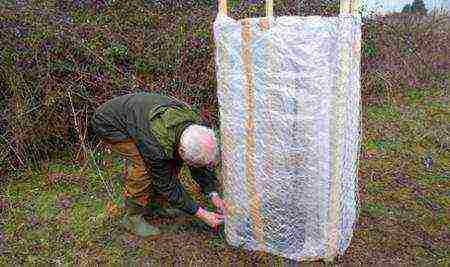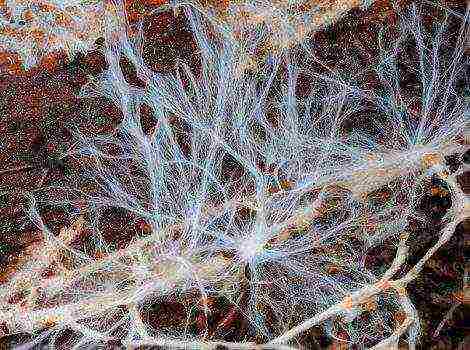Content
- 1 Seed stratification
- 2 Accelerated stratification
- 3 Seedling care
- 4 Wintering and transplanting seedlings into open ground
- 5 Conclusion
- 6 If we want to grow a cedar from seeds ...
- 7 How is the planting of cedar
- 8 Growing cedar in the open field
- 9 What seeds to choose and how to properly process them?
- 10 Accelerated seed processing
- 11 How to make a correct landing at home?
Siberian cedar is a symbol of health and strength, a tree of life that you can try to grow at home. Growing a cedar from a nut is not as difficult as it seems. First you need to purchase planting material: it is desirable that it be a whole cone with large scales - the seeds are stored in it better. It is important that it is fresh, of a new crop, without mold or foreign smell: such buds are sold in the fall, from the end of September. Roasted or dried pine nuts are not suitable for this purpose - the embryo dies at high temperatures. It is better to find a reliable seller in advance. You should not buy cones in places where cedars definitely do not grow.
Advice
To extract the seeds, the cone must be scalded with boiling water - then it will open. From the remaining scales, you can prepare a healing tincture or decoction, which are used to treat many diseases.
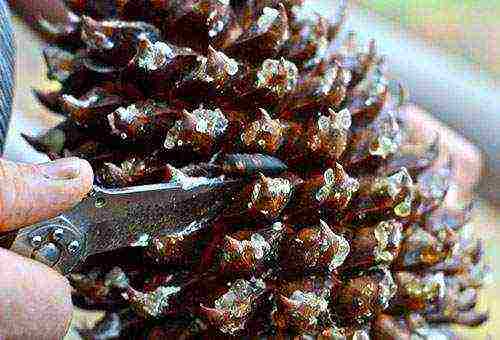
Seed stratification
When growing cedar at home, the only difficulty may arise: the stratification of seeds, which is necessary for their germination. It takes place in several stages.
- First, the nuts are soaked in hot water for three days, changing it daily. Some of them may float up - these are empty seeds, they can be thrown away immediately.
- The rest must be treated with a pale pink solution of potassium permanganate and a fungicide, dipping nuts into it for several hours.
- The next stage is cold stratification. Nuts need to be mixed with clean, moist fine-grained sand (you can pre-ignite it in the oven), sawdust or peat chips in a ratio of 1: 3.
- The resulting mixture must be placed in a cloth bag and put in a small wooden box, in which holes are made in advance so that there is air access.
- The container with nuts is placed on the lower shelf of the refrigerator (in the vegetable compartment) or placed in the cellar for at least 3 months. The temperature for seed germination should be about + 4-6 ° C, lowering to –4 ° C is allowed for no more than 2-3 days.
Every 15 days, the bag must be ventilated, the mixture must be moistened to its original state, and the nuts must not be rotted or moldy (the damaged ones must be removed and the sand replaced). After a while, they will start to sprout. The best period for sowing is considered to be April-May. If seeds are sown at this time without treatment, they can germinate after a year.
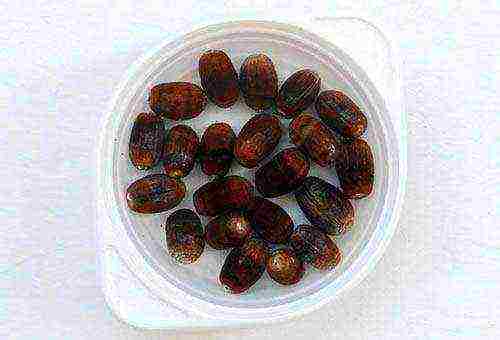
Accelerated stratification
There is a faster way to germinate cedar seeds at home, but it is less reliable than stratification in the refrigerator. You will need fresh, clean nuts, which must first be washed in warm water, freed from resin, and then kept in cold (no higher than 0 ° C) for about 3 days. It should not heat up, otherwise it will not work. To prevent this from happening, ice cubes can be periodically added to the container. Seeds that have sunk to the bottom are suitable for planting.
You can plant them in a substrate prepared in advance (sandy loam, loamy soils or a mixture of peat and sand are best suited), the temperature of which should not be higher than 15 ° C. Nuts are sown to a depth of 2-3 cm, compacting the soil from above - this will help the sprouts get rid of the hard shell. Containers are needed with a height of at least 8 cm and a volume of about 300 ml. Crops are mulched with sawdust or peat chips, placed in the lightest part of the house, but without access to direct sunlight, and watered regularly.The seedlings need a temperature of about 20-22 ° C.
Another option for fast stratification can be used.
- Pine nuts are soaked in warm water for about 8 days. It needs to be changed every 2 days.
- After that, a sand-peat mixture is made, into which the seeds are placed.
- Crops are kept at home at room temperature, periodically moistened and shaken, for 30 days, until they begin to hatch.
- The seedlings are then refrigerated and stored at about 0 ° C until planted in the ground or immediately planted in a pot.
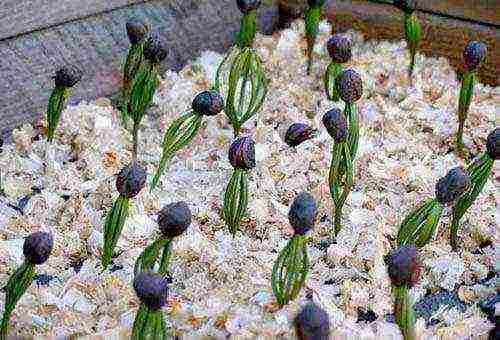
Seedling care
Growing cedar at home from seeds is somewhat more difficult than in the open field, since this tree is very demanding on lighting. If there is not enough light, it is best to supplement the seedlings with special lamps. It is necessary to prepare for the wintering of seedlings in the first year of life, if they stay at home, and will not be planted in the ground: they will need a temperature of no higher than 10 ° C. Such parameters can be on a glassed-in balcony or in a barn. If this condition is not met, young plants will die after transplanting into open ground.
Advice
One of the main enemies of crops is a fungal disease - "black leg". To prevent it, you need regular treatment of plants with a fungicide (once every 2 weeks).
It is better to start immediately accustoming young cedars to the open air: as soon as the threat of frost has passed, take them out into the garden or onto the balcony. This should be done gradually. Plants from seeds, grown at home, and not in the ground, are very delicate and can easily die from hypothermia or, conversely, overheating. The soil from above should be mulched with sawdust, pine needles or peat chips so that it does not dry out. Watering these plants needs moderate, no frills, otherwise the risk of decay of the root system will increase, but the soil should not be allowed to dry out. Cedars respond very well to feeding. For this purpose, you can use special fertilizers for conifers. They need to be brought in infrequently: 1 time in the spring and 2 times in the summer.
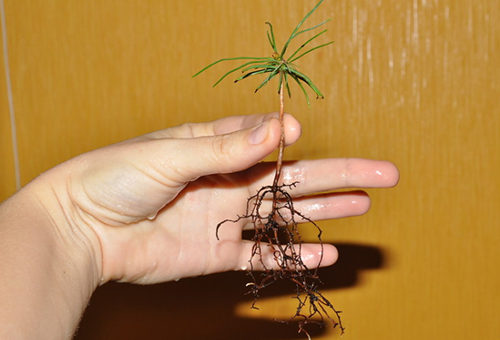
Wintering and transplanting seedlings into open ground
Young cedars grow very slowly: in the first year of life, they look like stems about 2–3 cm high with a bunch of short needles at the top. On the second, they can grow up to 7 cm, and in four years reach 20-30 cm. As they grow, the seedlings will need to be transferred into larger containers, making sure that they are planted at the same depth. Plants can overwinter at home on the balcony or in the garden; it is not necessary to add pots in drops if the temperature is not lower than 10 ° C.
Young cedars should be transplanted into open ground before they reach a growth of 1 meter. The landing site should be shaded, with a low level of groundwater. Such seedlings will bear fruit no earlier than in 20 years - for this you need to plant several trees so that they pollinate each other.
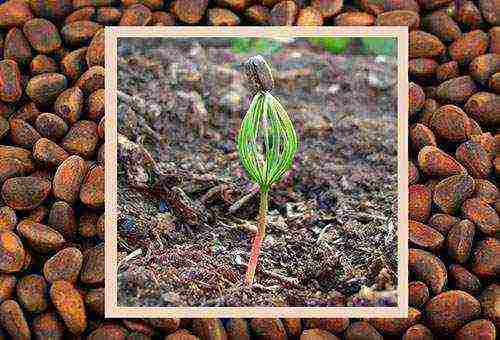
Conclusion
Growing cedar at home from seeds is complicated only by the need to stratify and create the right temperature for the wintering of seedlings. The latter is necessary to prepare plants for transplanting into open ground. Caring for young trees consists of regular watering and feeding.
In many ways, getting good seedlings depends on the planting material. When choosing, you need to focus on the size of the cone and its scales - the larger they are, the better. Cold stratification for several months gives an optimal result, as it is close to the natural conditions for seed germination. You can try several ways to grow a tree that will delight with the beauty not only its owner, but also his grandchildren.
.
Cedar is one of the most beautiful conifers. The duration of its life is 450-500 years, and the cedar pine reaches maturity by 80-85 years. This long-liver pleases not only with its sprawling long needles, but also with delicious pine nuts, rich in vitamins, microelements, fats and protein.
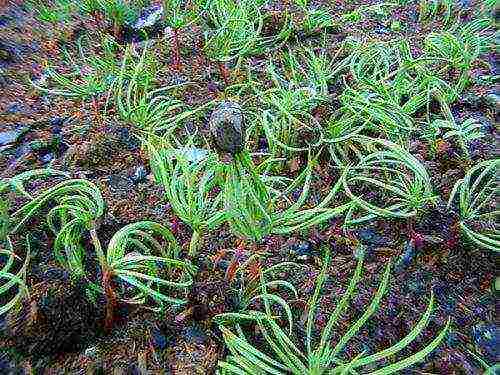
Cedar can be grown from a nut
You can meet cedars both in summer cottages and on the territory of country houses. Most often they are planted with annual seedlings, but not many people know how to grow a cedar from a nut at home.
Planting material
Growing a cedar from a nut is not an easy task, since there are no high-quality planting raw materials on sale. The nuts that you can buy in the store are absolutely not suitable for growing cedar at home. Most often they are shelled and fried. Not many people decide to sprout seeds on their own, because it is much easier to buy a one-year-old seedling and plant it in the ground.
Hand-buying pine nuts is also not a good idea. The seeds retain their germination for 1 year, in the second year it decreases by 50%, and after that the seed will not germinate at all.
In addition to the shelf life of nuts, its conditions can also be violated, which negatively affects the planting material.
To grow cedar from seeds at home, you have to collect pine nuts yourself. This can be done in places where cedar pine grows at the end of October, November. At this time, the collection of ripe cones begins. You can take seeds or buds with seeds that have fallen to the ground, but they can be damaged by mold or rodents, and there is a high probability that this will be last year's harvest.
It is better to pick the cone directly from the tree, but this is not easy due to the height of the cedar pines. Pickers use long sticks with mallets at the ends, knocking the buds off the very tops. These seeds have a higher chance of germinating.
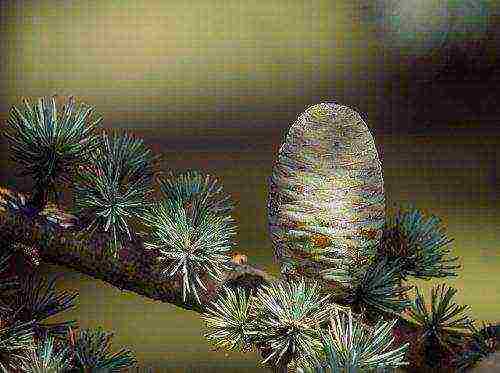
To collect seeds, it is best to pick the cone from the tree yourself.
Preparing seeds for germination
To plant seeds, you need to remove them from the bud. This is done quite simply. The cone is placed near heating appliances or quickly burned with a flame from all sides. Under the influence of temperature, the scales open up, releasing the seeds. On an industrial scale, special devices are used that crush the pine cone without damaging the pine nuts.
After removing the seeds, you need to take care of their disinfection. To prevent many fungal diseases, pine nuts are soaked in a solution of potassium permanganate for 2-3 hours before planting.
Planting seeds
An important point in the cultivation of cedar from seeds is stratification - the creation of conditions as close as possible to natural ones. In the forest, pine nuts, falling into the ground in November-December, winter under the snow and germinate only in spring. It's pretty easy to create something like this at home:
- After soaking in potassium permanganate, pine nuts are planted in a specially prepared substrate to a depth of 1–2 cm. Too deep planting prevents seeds from germinating.
- The seeds planted in a container are watered so that the whole earth is wet, but not sour from excess moisture. Otherwise, the nuts will start to rot.
- 5-7 cm of snow is laid on the surface of the substrate. The container is covered with polyethylene and placed on the lower shelf of the refrigerator for 3 months. If the weather conditions do not allow immediately covering the plantings with snow, then this can be done later.
- Once a month or as the soil dries, the nuts are watered with water at room temperature. It is advisable to use melted snow.
After 3 months of stratification, the container with the cedars planted in it is taken out of the refrigerator and placed on the south window. Most often, the first shoots appear already in the second week.
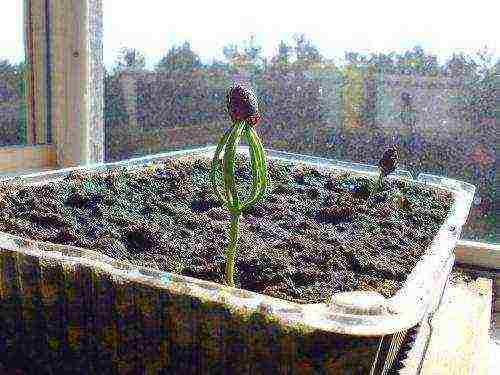
Cedar sprouts well on the south window
Seed planting substrate
The quality and composition of the soil play an important role in the cultivation of cedar at home. Seeds should be germinated in a mixture:
- river sand;
- small crumbs of gravel;
- peat.
Sand and gravel are calcined before planting. This prevents the development of many diseases, kills mold spores. Sometimes cedar seeds are germinated in a mixture of coniferous sawdust and fertile soil.Such a composition is very similar to the soil of a cedar forest, but it dries up quickly enough, so you need to carefully monitor the watering of the sprouted nuts.
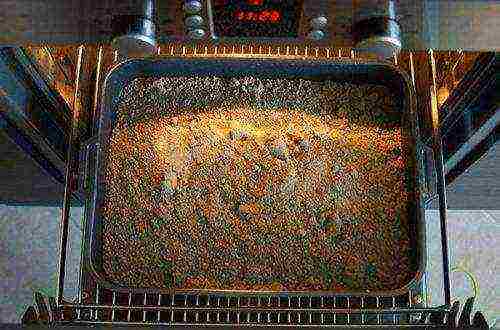
Before planting nuts, the soil should be calcined
Transplanting seedlings
When the cedar sprouts have reached 3 cm, they must be planted in separate containers, where they will grow for the first year. The main thing when transplanting is to carefully handle the delicate roots so as not to damage them.
Drainage is placed at the bottom of the pot, you can buy it at the store or use pine cones. The second option is better, because it brings the growing conditions closer to natural ones. The substrate is made from river sand, fertile soil and coniferous sawdust.
A month after transplanting, you can start hardening the seedlings. First, they arrange airing, and after a while they take it out into the street.
You cannot leave a young tree under the scorching sun, but the shade does not suit it either. You need to put the cedar pot in a place with a diffused shadow - under another tree or canopy.
For the first 10 years, cedar pine grows very slowly, but with good care it will grow sharply. It is better to plant a seedling in the ground up to three years. Such a tree is well accepted and easily tolerates winter.
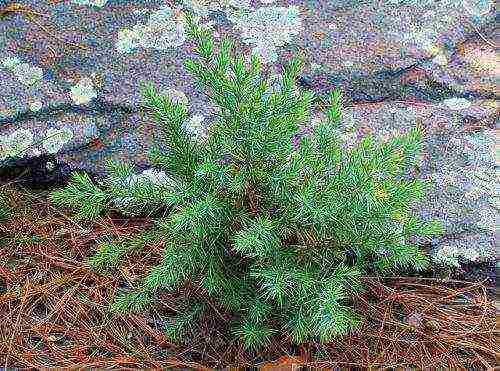
A three-year-old seedling can already be planted in the ground
Young tree care
If it was possible to plant a cedar in the country and the tree took root, then all the requirements for growing pine were carefully observed. Now you can start caring for the seedling. Remember the following guidelines:
- For full development, forest trees enter into symbiosis with myceliums. This useful neighborhood will help the cedar grown in the country to grow stronger. To do this, take 5 handfuls of forest litter and pre-chopped caps of ripe forest mushrooms, soak it all in a bucket of warm water. After a day, the cedar is watered with the resulting mixture.
- It is impossible to loosen the ground around the tree, since the roots are located very close to the surface, there is a possibility of damage.
- The soil around the seedling is mulched to retain moisture and control weeds. Shredded pine or other coniferous cones, sawdust, pine nut shells are used as mulch.
- Water the plant as the soil dries out, but the cedar reacts painfully to waterlogging and may die. Every year in the spring and autumn, you need to apply fertilizer for conifers. If you take good care of the cedar for the first 10 years of its life, then it will actively grow and bear fruit well.
Subscribe Be aware of new products on our site
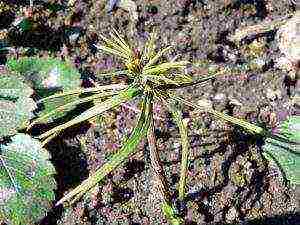
Let's work for Mother Nature and grow the famous Siberian tree on our site! The task is difficult, but doable. May inspiration not leave us and strength not run out!
If we want to grow a cedar from seeds ...
It will be more expensive to buy seedlings for growing, and they may not take root. Therefore, it is better to try to grow cedar from seeds on your own. It is necessary to seriously approach the issue of the choice of planting material. The seeds should not have any foreign smell. If the material is covered with mold in places, it is also not suitable for germination. However, when stored properly, seeds can last for several years.
Select the largest nuts for breeding. The following procedures are preliminarily carried out with them:
- soak;
- disinfection;
- stratification.
To prepare the seeds, they are soaked in warm water for 3 days. Moreover, the water is replaced with fresh water every day. Nuts gain moisture. To prevent seedlings from becoming infected with a fungus, cedar seeds are treated with a 0.5% solution of potassium permanganate for 2 hours.

Choosing nuts for planting
Then the nuts must be mixed with sand. The mixture must be moistened and placed in a natural fabric bag. They should be stored in a refrigerator at a temperature of about + 3 ° C. This is called seed stratification, that is, cold treatment. For storage, you should prepare a wooden box, make holes in it on the sides to ventilate the mixture.Place a bag of seeds in the box. In the cold, the workpiece is kept from autumn to spring.
During this time, it must be checked, moistened when drying. If moldy seeds appear, they must be removed and the sand around them replaced. There is a gradual softening of the shells. And from some even white roots begin to hatch.
How is cedar planting
After the required period of time, the seeds are removed and washed well. Then the nuts, ready for germination, are planted in pots filled with earth and sand. The sharp end of each seed should point downward. Planting depth is 1 cm. In this state, planting is kept for 1 month in the shade. It is necessary to grow seedlings at room temperature.
After a month, germination begins, and the pots are placed closer to the light, while not allowing direct sunlight to hit them. Roots appear from the nuts, rushing into the depths. A green sprout grows above the roots, in the upper part of which there is still an opened shell. After a few days, it subsides. At the top of the shoot, a bunch of green needles opens in the form of an umbrella. Usually about 30% of all seeds germinate. This is considered a normal result.
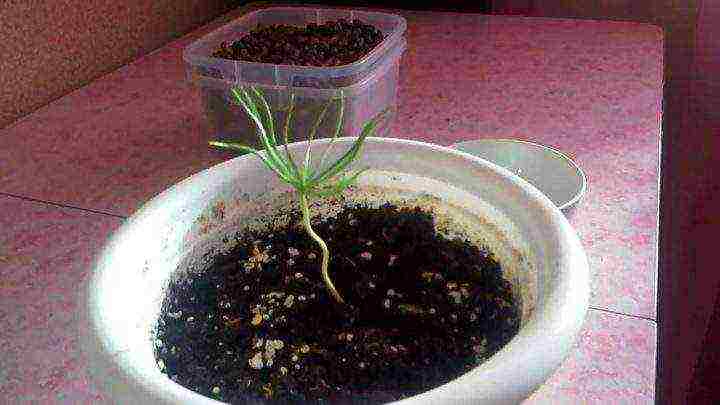
Cedar sprout
When summer comes, the seedlings are taken out into the fresh air. And for the winter, it is better to hide it in a greenhouse. There you need to water it and feed it with fertilizer every six months.
As the shoots grow, they have to be transplanted into large containers. Young seedlings can not be transplanted until 3-4 years old. By this time, they reach a height of 25-30 cm.
Now they can be planted in an open area in loose soil enriched with fertilizer. It is better to do this in the spring. First, the seedlings are taken out into the air in pots, and after getting used to the new conditions, they can be planted in the ground.
Before planting a cedar in the ground, you need to prepare:
- appropriate place;
- soil;
- seedlings correctly taken out of the pots.
Trees can be planted in an area where groundwater does not rise above 3 m. When planting shoots, it is important to maintain the integrity of all roots and capture them with the ground.
Peat with earth and sand is used as planting soil. After the tree is planted, it must be watered so that the density of the soil becomes uniform. From above it is recommended to mulch with sawdust or chopped coniferous needles.
Growing cedar in the open field
There is another way how to grow a cedar from a nut. Without the greenhouse stage, the seeds can be sown directly into open ground. It will be necessary to carry out systematic watering and weeding. You also have to make sure that the crops are not attacked by mice or birds. If the seedlings survive, they will grow and develop in the same way as greenhouse ones.
Many gardeners use ready-made special soil for coniferous plantations. Mineral and organic fertilizers must be added to it in the soil.
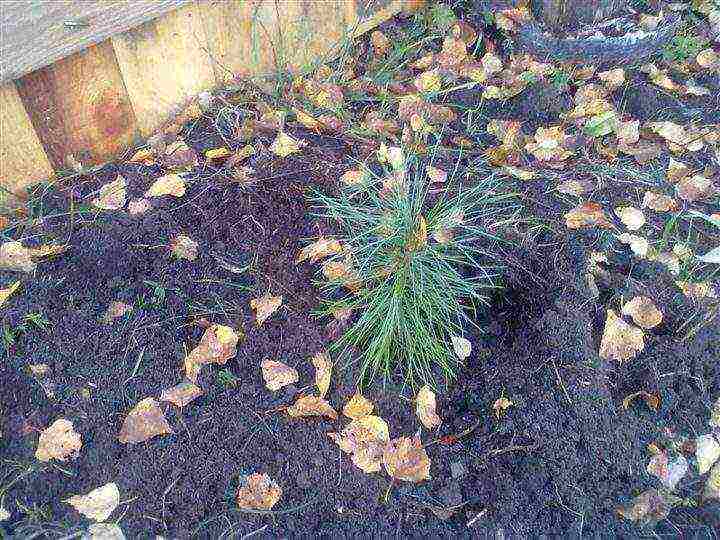
Cedar in the open field
In a coniferous forest, litter is taken from under the trees and planting sites are enriched with it. The litter protects the soil from moisture loss, which is dangerous for conifers. If at least part of the roots dries up, then the whole tree may die.
When planting, a distance of at least 3 m should be left between the cedars. The surrounding neighboring trees should also not interfere with the growing cedars. It is known that cedar trees grown in a spacious area can be enjoyed much earlier than those planted in the shade, next to others. And after 18-20 years, cones are formed on them. In some trees, the fruiting age can be delayed up to 40 years.
For 1 year, the sprouts should be in a shaded area of the garden. The ground must be moist. In hot weather, you can periodically spray the needles to give them freshness.
If you have to transplant a plant that has reached a height of 1 m to a new place, this can only be done in the spring. At the same time, it is moved with a large volume of land.Around the tree it should be about 0.5 m. For adult seedlings from grass, weeds or fallen needles, mulching is done. It must be remembered that excessive moisture in cedar is harmful, just like drought.
Growing requires a lot of patience. Growth is slow. So, plants after 1.5 years have a height of several centimeters. Despite the fact that the cedar grows for a long time, it will delight others with its beauty.
Who doesn't want to have a self-grown evergreen tree at home! We are talking, of course, about the famous Siberian cedar. To some, this task may seem difficult, but this is wrong. With minimal knowledge and funds, you can grow a cedar tree literally on your windowsill. But the question of how to do it most correctly will be answered by this material.
So, it should be noted that we are not talking about the classic cedar from the cedar family, but about its "colleague" - the cedar pine. Despite the visual and other similarities, they are still different types of plants. Take, for example, the notorious nuts: in the classic cedar, they are inedible and hazardous to health. But in perfumery and medicine, it is its essential oil that is used, and not cedar pine oil.
First of all, it is necessary to pay due attention to the selection of seed and planting material.
What seeds to choose and how to properly process them?
First you need to take into account that the most suitable material for growing cedar is a cedar cone with the largest possible scales. As a rule, it contains higher quality and more viable seeds. Each bump should be checked for foreign plaque or odor. So, if you feel a pronounced mold, then such seeds are unlikely to give at least some kind of harvest.

It is important to know that the most suitable for planting cedar cones appear on sale only in the fall. Only at this time of year are they sure to be fresh.
The seeds are extracted very simply: the cone is poured over with boiling water, which makes it open in speed. In this case, all the "side" material left over from the extraction of seeds can also come in handy.
Many experts make medicinal decoctions and tinctures from the flakes that have arisen.
High-quality cedar seeds do not need any specific processing, but their stratification is quite troublesome. It happens through the fulfillment of the following mandatory points:
- for three days, the seeds must be soaked in heated water, while the water must be replaced daily with fresh water;
- empty seeds must be sifted out every day. It is very simple to define them - they will appear on the surface;
- after three days, the prepared seeds are treated with a weak solution of potassium permanganate;
- then the seeds are immersed in a fungicide solution for at least three hours;

The above procedures represent hot stratification. But it is also necessary to carry out cold processes. So, performing cold stratification, it is necessary to do the following mandatory manipulations:
- pre-purchased fine sand must be properly calcined in the oven. Then, after letting it cool, prepared cedar seeds are added there. Sawdust and peat are also added to the mixture in a ratio of 1: 3;
- when the mixture becomes homogeneous, it is poured into a "breathing" bag, which, in turn, is placed in a wooden box or box. In such a homemade container, ventilation holes must be made, otherwise the seeds will die;
- then the container is placed on the lower tier of the refrigerator, or in the cellar (but not in the freezer!) for three months.
With all this, every two weeks the mixture must be ventilated and moistened, monitoring the condition of the seeds. It's okay if some of them rot. Then they need to be removed and the sand replaced with fresh.
Sowing is best started in May or April.
Accelerated seed processing
For those who do not have time to prepare seeds for planting for a long time, the following method can be proposed. It also implies performing the following actions:
- pour new hot water over the seeds every two days. This must be done within 8 days;
- place the seeds in a sand and peat mix;
- within a month, the seeds are regularly moistened and kept at home;
- all this is stored at a temperature not higher and not lower than 0 degrees in the refrigerator. At the same time, the condition of the seeds must also be carefully monitored.
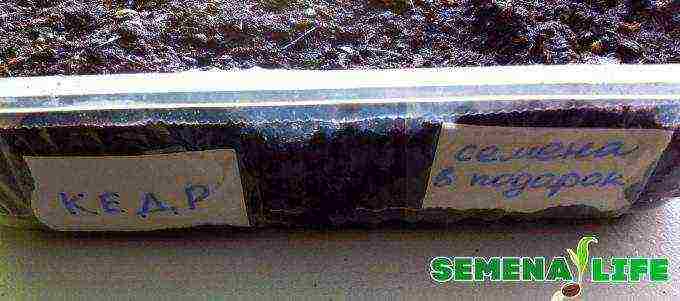
How to make a correct landing at home?
The final stage is the transplanting of prepared seedlings. Unfortunately, many fail at this stage. However, taking into account the following useful tips, you can avoid common mistakes, and therefore achieve the desired result.
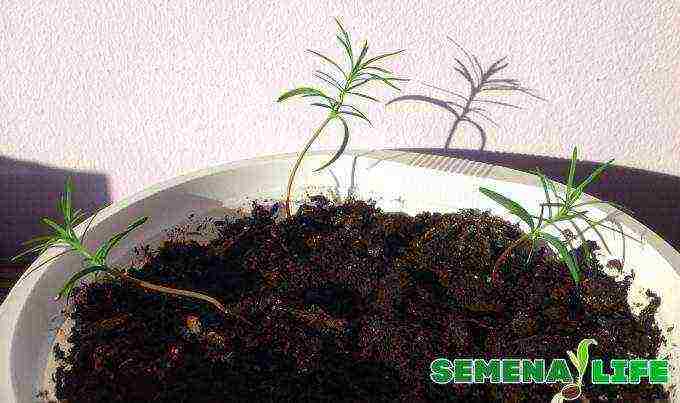
So, seedlings need to be illuminated most of the day with special lamps at a temperature not higher than 10 degrees. Failure to comply with this condition threatens the death of recently appeared shoots.
It is also necessary to regularly take the plants out into the cold so that they form a kind of immunity.
And the last tip: the cedar is incredibly fond of feeding. It is sold in any specialized store and it will not be difficult to choose it. But you need to apply it not so often - a couple of times in the summer and once in the spring.

